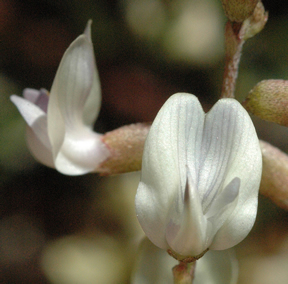Applegate's milkvetch facts for kids
Quick facts for kids Applegate's milkvetch |
|
|---|---|
 |
|
| Conservation status | |
| Scientific classification | |
| Genus: |
Astragalus
|
| Species: |
applegatei
|
Applegate's milkvetch (scientific name: Astragalus applegatei) is a very rare wild plant. It is a type of milkvetch, which belongs to the pea family. This special plant is found only in Klamath County, Oregon, in the United States. It is considered an endangered species by the U.S. government. This means it is at high risk of disappearing forever.
Contents
About Applegate's Milkvetch
This section will tell you more about what Applegate's milkvetch looks like and where it grows.
What it Looks Like
Applegate's milkvetch is a plant that lives for many years. It grows from a main root that goes deep into the ground, called a taproot. Its stems can spread out or lie flat on the ground. They can form wide mats, almost a meter (about 3 feet) across. The plant can grow up to 40 centimeters (about 16 inches) tall.
The leaves of the plant are up to 8 centimeters (about 3 inches) long. Each leaf is made up of several pairs of smaller leaflets. These leaflets are about 1 to 2 centimeters (less than an inch) long.
Flowers and Fruits
The flowers of Applegate's milkvetch grow in a cluster called a raceme. These flowers usually nod downwards. Each flower has a cup-shaped part called a calyx, which is made of small leaf-like parts called sepals. The calyx is covered in black hairs.
The petals of the flower form a part called the corolla. They can be whitish to light purple, often with purple tips. After the flowers bloom, the plant produces a fruit. This fruit is a pod, similar to a pea pod, and is about 1 centimeter (less than half an inch) long. It often has purple spots.
Where it Lives
Applegate's milkvetch grows in a special type of natural home, or habitat. It prefers areas that are part of a floodplain in the Klamath Basin. A floodplain is a flat area of land next to a river or stream that sometimes gets covered with water. The soil in these areas is often wet during certain times of the year.
This plant also needs a specific type of soil. It grows best in alkali soils. These soils have a high pH level, meaning they are more basic than acidic.
Why it's Endangered
Applegate's milkvetch is a federally listed endangered species. This means it has strong legal protection in the United States. However, it still faces many challenges that threaten its survival.
Threats to the Plant
There are only three known groups of Applegate's milkvetch plants left. One of these groups has only three plants, which is very small. The places where these plants grow are in danger.
- Development: New buildings, roads, and other construction projects can destroy the plant's habitat. For example, one group of these plants was lost when its habitat was turned into a grocery store and a car dealership.
- Introduced Species: Plants from other parts of the world can be brought into the area. These introduced species can grow very fast and take over the space and resources that Applegate's milkvetch needs to survive.
- Small Populations: The groups of plants that are left are very small. When a plant population is tiny, it can lose its genetic variety over time. This makes the plants less strong and less able to adapt to changes or fight off diseases.
Conservation Efforts
The largest group of Applegate's milkvetch plants is partly protected by an organization called The Nature Conservancy. They work to save important natural areas. However, other parts of this plant's habitat are still at risk from development. Protecting these rare plants and their homes is very important to make sure they don't disappear forever.
See also
 In Spanish: Astragalus applegatei para niños
In Spanish: Astragalus applegatei para niños


